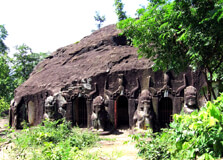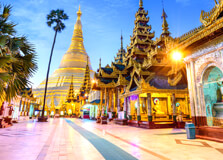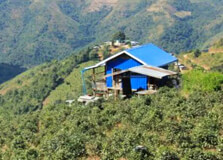
- Home
- Travel Packages
- Top Destination
-
Travel Attraction
By Category
Top Attraction

- Travel Agents
- Car Rentals
- Hotels

Hpowindaung, also known as Po Win Daung, is one of Myanmar’s most unique and sacred archaeological and religious sites. Located near the town of Monywa in the Sagaing Region, Hpowindaung is a remarkable complex of over 900 sandstone caves carved into the hills. These caves are home to thousands of ancient Buddha statues and beautiful wall paintings that date back as far as the 14th century. The site is considered one of the richest collections of Buddhist mural paintings and sculptures in Southeast Asia. Set in a tranquil, rural landscape, Hpowindaung attracts pilgrims, historians, photographers, and tourists looking to explore Myanmar’s rich spiritual and artistic heritage. How to Reach Hpowindaung, Monywa Hpowindaung is located about 25 kilometers west of Monywa town. To reach Monywa, travelers can take a bus, private car, or shared taxi from major cities like Mandalay or Bagan. From Mandalay, it takes approximately 3 to 4 hours by road. From Bagan, the journey can take around 5 to 6 hours. Once in Monywa, visitors can hire a local taxi, motorbike, or join a group tour to reach Hpowindaung. The drive includes a scenic route across the Chindwin River and through peaceful countryside. Most tours to Hpowindaung also include a stop at the nearby Shwe Ba Taung cave complex. Weather in Hpowindaung and Monywa Monywa and the Hpowindaung area experience a tropical climate. The best time to visit is during the dry season from November to February when temperatures are cooler and more comfortable, ranging from 20°C to 30°C (68°F to 86°F). March to May is the hottest period, with daytime temperatures often exceeding 40°C (104°F). The rainy season from June to October can make travel more difficult due to muddy roads and heavy rainfall, though the landscape becomes lush and green. Timings Hpowindaung caves are typically open to visitors daily from around 8:00 AM to 5:00 PM. While there is no official gate or ticket office, it’s best to visit during daylight hours for safety and visibility, as the caves can be dark and uneven inside. Arriving in the morning allows for more time to explore the many caves and appreciate the murals in natural light. Why is Hpowindaung, Monywa Famous? Hpowindaung is famous for its extensive network of hand-carved sandstone caves that contain thousands of Buddha statues, frescoes, and carvings. It is one of the largest and most impressive cave complexes in Southeast Asia and is highly regarded for its historical, artistic, and spiritual value. The site showcases an extraordinary mix of Indian, Chinese, and Burmese influences in Buddhist art. The murals and carvings depict scenes from the Jataka tales (stories of the Buddha’s past lives), as well as local myths and religious themes. Entry and Visit Details There is no formal entrance fee to visit Hpowindaung, but small donations are encouraged and appreciated. These help local caretakers maintain the site. Some visitors also tip local guides or monks who offer tours or information. Visitors should wear modest clothing, covering shoulders and knees, and must remove shoes before entering sacred areas. Flash photography is usually discouraged inside the caves to protect the fragile murals. History and Architecture of Hpowindaung Hpowindaung dates back to between the 14th and 18th centuries, with many caves being used as meditation chambers or temples. According to local legends, the complex was named after a famous hermit monk named Po Win, who meditated in the caves. The caves are carved directly into the soft sandstone hills. Each cave varies in size and design—some are simple with a single statue, while others are large chambers decorated with colorful murals and dozens of Buddha images. The artistry reflects the cultural and religious evolution of Myanmar during this time period. Things to Do at Hpowindaung Explore the 900+ cave temples filled with ancient Buddhist art and sculpture. Admire the colorful frescoes depicting stories from Buddhist scriptures. Take photos of the serene landscape and architecture (with respect to sacred areas). Visit the nearby Shwe Ba Taung, where temples are carved into vertical cliffs. Learn about Burmese Buddhist history and local legends from a local guide. Enjoy the peaceful, meditative atmosphere away from city noise. Facts about Hpowindaung, Monywa There are over 900 individual caves in the Hpowindaung complex. The murals are made with natural pigments and have lasted for centuries. Some caves have been dated back as early as the 14th century. The site reflects Indian, Mon, and Burmese artistic influences. It is one of the largest repositories of ancient Buddhist art in Myanmar. Hpowindaung is a protected archaeological site under the Ministry of Culture. Tips for Visiting Hpowindaung, Monywa Wear comfortable walking shoes suitable for uneven and rocky paths. Bring a flashlight or phone torch to see inside the darker caves. Stay hydrated and bring bottled water, especially during hot seasons. Respect local customs—remove shoes in sacred areas and avoid loud noise. If you want in-depth understanding, consider hiring a local guide. Try visiting early in the morning to avoid heat and crowds. Bring a camera but use it respectfully—some areas may prohibit flash photography.
Explore More
Thein Taung Pagoda is one of the most iconic religious sites located in Kalaw, a charming hill town in Shan State, Myanmar. Positioned atop a hill near the center of Kalaw, the pagoda offers stunning panoramic views of the town, surrounding mountains, and pine forests. It is not only a spiritual destination for Buddhist pilgrims but also a scenic attraction for travelers seeking peace, nature, and cultural exploration. The pagoda is part of a monastery complex known as Thein Taung Monastery and is a significant spiritual center for the local community. With its elevated location and peaceful ambiance, it is a place for reflection, prayer, and meditation. Its beauty, accessibility, and cultural value make Thein Taung Pagoda a must-visit site for anyone traveling to Kalaw. How to Reach Thein Taung Pagoda Kalaw is located in the western part of Shan State and is well connected by road, rail, and air. The nearest airport is Heho Airport, about 45 kilometers away, which has regular flights from major cities like Yangon and Mandalay. From Heho, travelers can reach Kalaw by taxi, car, or shared minivan in about 1.5 hours. Once in Kalaw town, Thein Taung Pagoda is just a short walk from the central market and main road. Visitors can follow a staircase that winds uphill from the town center, leading directly to the pagoda. It takes about 10 to 15 minutes to reach the top, and the walk itself is scenic and peaceful. For elderly visitors or those with mobility issues, tuk-tuks or motorbikes can be hired to reach the base of the hill closer to the pagoda entrance. Weather in Kalaw Kalaw has a mild, temperate climate due to its location at an elevation of about 1,300 meters (4,265 feet) above sea level. This cool weather makes it a perfect destination for exploring outdoor attractions like Thein Taung Pagoda. The dry season from November to February is the best time to visit, with temperatures ranging between 10°C to 20°C (50°F to 68°F). This period offers clear skies and comfortable weather. From March to May, temperatures rise slightly, while the rainy season from June to October brings frequent rainfall and lush scenery, though trails may be slippery. Timing Thein Taung Pagoda is open to visitors every day, generally from sunrise to sunset (around 6:00 AM to 6:00 PM). Visitors are encouraged to come early in the morning for a peaceful experience or in the late afternoon to enjoy a stunning sunset view over the town of Kalaw. Entry to the pagoda and monastery is free, though donations are welcome and help with the maintenance of the site. Why is Thein Taung Pagoda Famous? Thein Taung Pagoda is famous for its panoramic views, spiritual ambiance, and easy accessibility. The hilltop location provides one of the best vantage points in Kalaw, making it a popular place for both sunrise and sunset photography. In addition to its natural beauty, the pagoda is renowned for being a peaceful place of worship and meditation. Many monks reside at the adjoining Thein Taung Monastery, and visitors often witness traditional Buddhist rituals and chanting, which add to the spiritual charm of the place. The pagoda is also part of the local trekking routes, making it a common stop for hikers exploring the region. Entry and Visit Details There is no official entrance fee to visit Thein Taung Pagoda. However, donations are encouraged, especially if you enter the monastery or spend time meditating at the site. As with all religious sites in Myanmar, visitors must remove their shoes and socks before entering the pagoda grounds. It is also important to dress modestly, covering shoulders and knees, as a sign of respect. History and Architecture Thein Taung Pagoda has a long history rooted in the Buddhist traditions of Shan State. It was built several decades ago and has since become a spiritual center for locals and monks living in the area. The nearby Thein Taung Monastery has served as a training center for novice monks and continues to play a vital role in the religious life of Kalaw. Architecturally, the pagoda features a traditional Burmese stupa style with a golden spire that gleams in the sunlight. The surrounding structures include prayer halls, small shrines, and living quarters for monks. The entire complex is designed to provide peace and inspiration for spiritual practice. Things to Do at Thein Taung Pagoda Climb the scenic staircase and enjoy panoramic views of Kalaw and surrounding hills. Explore the pagoda and admire its traditional architecture and peaceful gardens. Join locals in meditation or prayer at the pagoda or monastery. Visit in the early morning for a serene sunrise or in the evening for sunset views. Talk with resident monks to learn about Buddhist teachings and life in the monastery. Photograph the beautiful views, architecture, and surrounding nature. Facts about Thein Taung Pagoda Thein Taung Pagoda is located on a hill just a short walk from Kalaw town center. The name "Thein Taung" roughly translates to “Mountain of the Ordination Hall.” The site includes both a pagoda and a monastery, which houses Buddhist monks. It offers some of the best views in Kalaw, especially at sunrise and sunset. The site is peaceful, less crowded, and ideal for meditation and reflection. Tips for Visiting Thein Taung Pagoda Wear modest clothing and be prepared to remove your shoes before entering. Visit early morning or late afternoon for the best views and lighting. Be respectful of the monks and local worshippers — speak quietly and avoid interrupting ceremonies. Carry water, especially if you're walking uphill from the town center. Bring a camera to capture the sweeping views and the spiritual ambiance. If trekking around Kalaw, include Thein Taung Pagoda as a cultural stop on your route. Support the monastery with a small donation if you spend time exploring or meditating on the grounds.
Explore More
Trekking around Kalaw is one of the most popular and rewarding activities for travelers visiting Shan State in Myanmar. Kalaw, a former British hill station nestled at about 1,300 meters above sea level, is surrounded by green hills, pine forests, tea plantations, and ethnic villages. It has become a starting point for some of the most scenic and culturally rich treks in Southeast Asia. Whether you're an experienced trekker or a first-timer, Kalaw offers a variety of trekking routes ranging from short one-day walks to multi-day journeys — most famously the Kalaw to Inle Lake trek. Along the way, you'll pass through Pa-O, Danu, Palaung, and Taung Yo villages, offering a chance to experience rural life and traditional hospitality. How to Reach Kalaw for Trekking The nearest airport to Kalaw is Heho Airport, located about 45 kilometers away. Heho is well-connected by domestic flights from major cities like Yangon, Mandalay, and Naypyidaw. From the airport, you can take a taxi or minivan to Kalaw, which takes about 1.5 hours. Kalaw is also accessible by road and rail. Buses and private cars frequently run from cities such as Mandalay, Bagan, Taunggyi, and Inle Lake. If you prefer a more scenic journey, you can take a train from Thazi — the ride offers picturesque views of the mountains, though it's slow. Once in Kalaw, trekking agencies, guides, and hostels can help you plan and start your trek easily. Weather in Kalaw Kalaw enjoys a cool, temperate climate year-round thanks to its elevation. The best time for trekking is during the dry season (November to February), when the weather is cool and the trails are dry. Daytime temperatures range between 15°C to 25°C (59°F to 77°F), making hiking pleasant. The summer months (March to May) are warmer and drier, still suitable for trekking, but it can get hot in the afternoons. The monsoon season (June to October) brings lush scenery, but also muddy trails, making trekking more difficult. Timing for Trekking Around Kalaw Treks can start as early as 7:00 AM and typically end by late afternoon or evening, depending on the distance. Multi-day treks start early on the first day and finish by noon or afternoon on the last day. The Kalaw to Inle Lake trek usually takes 2 to 3 days and involves walking 5–6 hours per day, covering around 40–60 kilometers. For shorter treks, such as half-day or full-day village walks, you can start mid-morning or after breakfast. Why is Trekking Around Kalaw Famous? Trekking around Kalaw is famous for its combination of natural beauty, cultural encounters, and physical adventure. It offers a chance to walk through misty forests, rolling hills, terraced farms, and ethnic villages untouched by modern development. Trekkers often highlight the hospitality of the local villagers, homemade food, and the opportunity to sleep in rural homes or monasteries. The final destination for many is Inle Lake, one of Myanmar’s top attractions, which adds even more value to the experience. Entry and Visit Details Trekking in Kalaw does not require a permit for most tourists, and there are no official entry fees. However, hiring a local guide or joining a tour is highly recommended for safety and to enhance the experience. Guided treks are affordable and typically include meals, accommodation (homestays or monasteries), and luggage transport if needed. Prices for a 2-day trek range from $20 to $40 USD per person, depending on group size and included services. It’s advisable to book through a local trekking agency or your hotel/guesthouse in Kalaw a day in advance. History and Cultural Background Kalaw was established as a hill station by the British during the colonial era due to its cool climate. Today, it retains much of its colonial charm with old buildings, churches, and gardens. The trekking routes wind through remote areas inhabited by various ethnic groups including the Pa-O, Palaung, Danu, and Taung Yo people. These communities have preserved their unique customs, dress, and languages, making the trek as much a cultural journey as a physical one. Things to Do While Trekking Around Kalaw Walk through tea plantations, bamboo forests, and rice paddies. Visit traditional villages and observe rural life. Sleep in a local homestay or Buddhist monastery. Learn about the culture and beliefs of Myanmar’s hill tribes. Watch or help locals cook traditional meals with fresh, local ingredients. Experience spectacular sunrises and sunsets over mountain ranges. End your trek at Inle Lake and enjoy a boat ride or lakeside relaxation. Facts about Trekking Around Kalaw The Kalaw to Inle Lake trek is around 50–60 km and usually takes 2–3 days. Most treks are guided and include meals and overnight stays in villages. Kalaw was a British colonial retreat, still known for its cool climate and pine forests. Over 30 ethnic groups live in Shan State, many of which can be encountered during treks. Trekking is eco-friendly and helps support local communities through tourism. Tips for Trekking Around Kalaw Wear comfortable, breathable clothing and good walking shoes or hiking boots. Pack light, but bring essentials like a water bottle, sunscreen, hat, and insect repellent. Be respectful of local customs and always ask before taking photos of people. Support the community by buying local handicrafts or produce. Consider tipping your guide and hosts to show appreciation. Travel with a reusable water bottle and avoid single-use plastics. Book your trek with a reputable guide or agency with positive reviews.
Explore More